All things being equal, the fire would have spread consistently. But the NIST computer model inexplicably bypassed the offices to the southwest of column 79, burned around column 79 on the east side, and then, two hours later, burned the offices to the southwest of column 79.
BURNED-OUT FIRE
Chris Sarns’ research appears in Dr. David Ray Griffin’s book, The Mysterious Collapse of World Trade Center 7. Sarns has been deeply involved in the work of AE911Truth, where he provides his expertise on WTC 7.
The studies in this five-part series, written for Architects & Engineers for 9/11 Truth and originally published between May and September 2013, represent years of work that Sarns did in unraveling some of the most glaring inconsistencies and outright frauds in the NIST report on World Trade Center 7. He demonstrates that NIST’s theory of a fire-induced collapse of Building 7 is faulty and misleading. The destruction of this skyscraper on September 11 was truly unprecedented in the history of high-rise buildings.
Part 1 of Sarns' series (below) was first published in May 2013, when close to 2,000 architects and engineers at AE911Truth were demanding a new investigation. By December 2016, the number of A/E petition-signers had swelled to nearly 2,750.
In this five-part series, I will expose and disprove NIST's false claims in five critically important areas:
- BURNED-OUT FIRE — The timing of the fire on Floor 12 exposes NIST's false claim that fire led to the collapse.
- MAGICAL THERMAL EXPANSION — NIST used numerous unscientific methods and fraudulent inputs to get the key girder to fail in its computer simulation.
- MISSING SHEAR STUDS — NIST’s claim in its Final Report about the lack of shear studs on the floor support girder between columns 44 and 79 is exposed.
- FICTITIOUS DEBRIS DAMAGE — The fictitious “10-story gouge” claimed early on by NIST in WTC 7’s south face is exposed.
- NON-EXISTENT DIESEL FUEL FIRE — NIST’s fraudulent diesel fuel fire hypothesis is exposed.
NOTE: Quotes from NIST's WTC 7 reports are shown inBold Light Blue.
The timing of the fire on Floor 12 exposes NIST's false claim that fire led to the collapse.
Below, the four images in the middle column are photographs taken of World Trade Center 7 at four different times in the afternoon of September 11, 2001.
The four graphics in the left column are my approximations, using the photographs as a guide, of where—and at what times—a fire was actually burning on Floor 12.
And the four graphics in the right column are NIST's ANSYS computer model of where the fires were burning in the building at the same four times.
“Note that only window glass breaking times were prescribed in the fire model. The observed fire activity gleaned from the photographs and video were not a model input.” — NCSTAR 1-9, Vol. 2, page 378 [PDF page 444]
NIST will not release the input data because doing so, it claims, might “jeopardize public safety.”
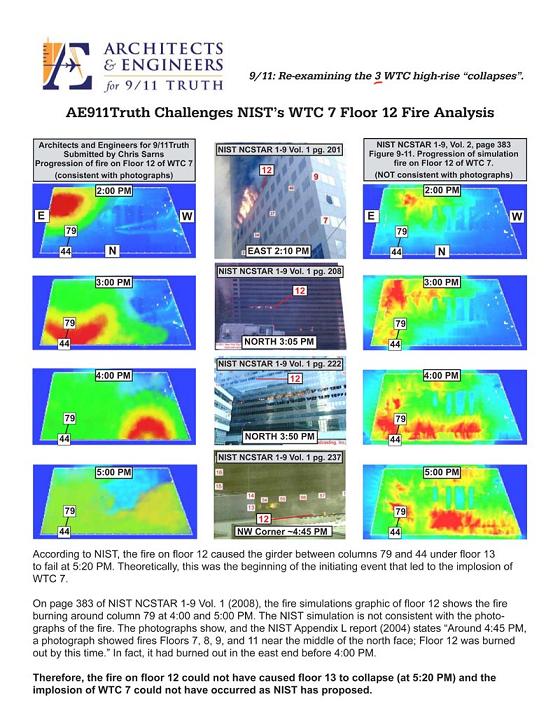
Quotes and photographs from the NIST reports on the collapse of WTC 7
Quotes on the spreading of the fire:
“On those floors that were mostly subdivided into offices (such as Floors 11 and 12), the fire would have grown within a single office, reaching flashover within several minutes. After about 5 to 15 min, the ceiling tile system would have failed from the heat, and the hot air would have flowed over the office wall. Soon the hot air would fail the ceiling of an adjacent office, and eventually the thermal radiation would ignite the contents in this office. Fire spread would have been similar for offices separated by a corridor, although this would have taken longer, since the hot air would have to travel further and would be cooling along the way.” — NCSTAR 1A, page 19 [PDF page 61]
“The mass of the furnishings per office was not known” — NCSTAR 1-9, Vol. 1, page 60 [PDF page 104]
“[T]he average combustible fuel load on the 11th and 12th floors was estimated as 32 kg/m2.” — NCSTAR 1-9, Vol. 2, page 376 [PDF page 442]
All things being equal, the fire would have spread consistently. But in the NIST computer model, the fire inexplicably bypassed the offices to the southwest of column 79, burned around column 79 on the east side, and then, two hours later, burned the offices to the southwest of column 79.
“Fires . . . on Floors 11 to 13 persisted in any given location for approximately 20 min to 30 min.” — NCSTAR 1A, page 47 [PDF page 89]
Photos showing progression of fire:
“From 11:30 a.m. to 2:30 p.m. Looking from southeast corner to the south face.
Fire on floor 12;[1] area above covered with smoke.
Fire on floors 11-12[1] moved to east face and progressed to the north.
[1] [F]ires reported on floor 14, but photographs showed east face fires on floor 12.” — Part IIC, page 21
“Fire was first seen on the 12th floor at 2:08 p.m. toward the south end of the east face. Further south on this face, the window glass was still intact, indicating that this fire had burned in the building interior as it turned the southeast corner.” — NCSTAR 1A, page 20 [PDF page 62]
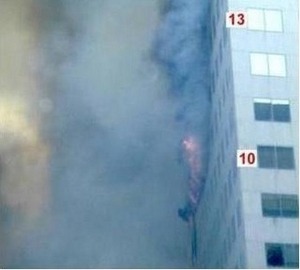
“By around 2:30 p.m., the visible flames had diminished, but the fire had spread both south into the southeast corner and north, reaching two-thirds of the way to the northeast corner.” — NCSTAR 1A, page 20 [PDF page 62]
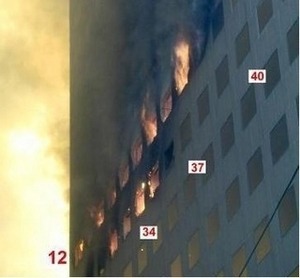
Fire first appeared on the north face of Floor 12 about 80 feet from the northeast corner:
“By 3:00 p.m., the fire had spread internally past the northeast corner and onto the north face.” — NCSTAR 1A, page 20 [PDF page 62]
The fire spread internally through the offices around column 79 and under the beams, which allegedly underwent enough thermal expansion to push a girder off its seat and initiate the “global collapse” at 5:20 PM.
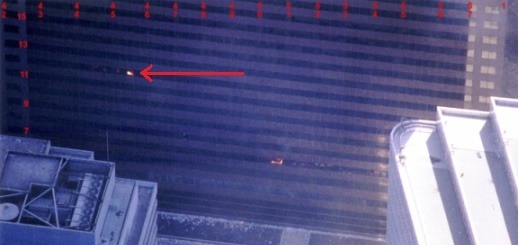
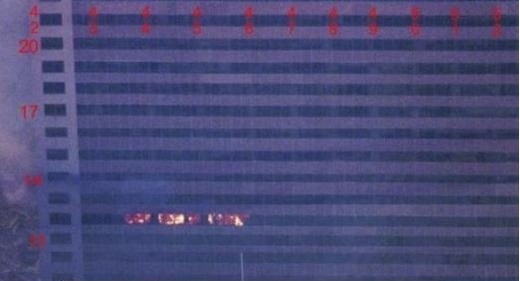
“In less than 15 min, the fire simultaneously spread rapidly to the east to engulf the northeast corner of the floor and more slowly westward about one-third of the way across the north face.” — NCSTAR 1A p. 20 [PDF page 62]
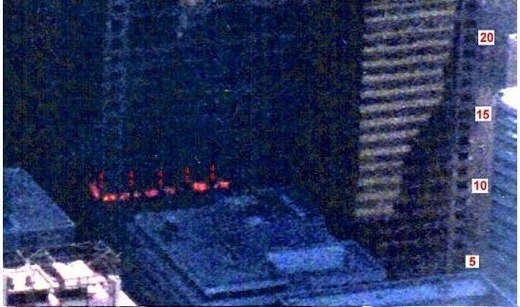
“The fire continued spreading westward in starts and stops, approaching the northwest corner of the floor around 3:45 p.m.” — NCSTAR 1A, page 20 [PDF page 62]
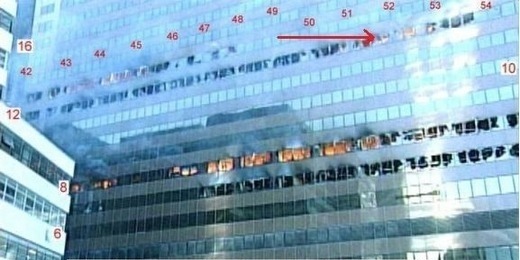
The photographs reveal that the fire on Floor 12 had progressed from the south side of the building to the north side via the interior offices by 3:00 PM and had engulfed the northeast corner by about 3:15 PM. This means that the fire in the area in question (around column 79 and under the beams and girder in the northeast corner) had burned out by about 3:50 PM, because, as noted above, the fires burned for only about 20 to 30 minutes in any given location.
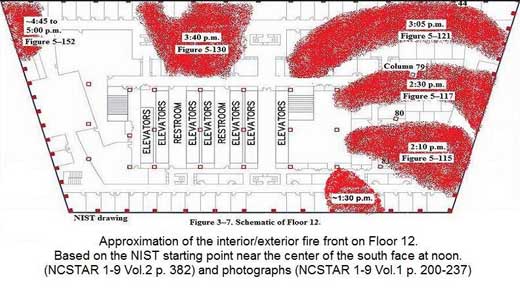
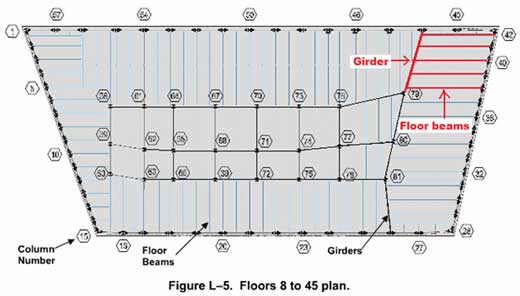
References:
NCSTAR 1-9 Vol.1 and 2 Structural Fire Response and Probable Collapse Sequence of World Trade Center Building 7
